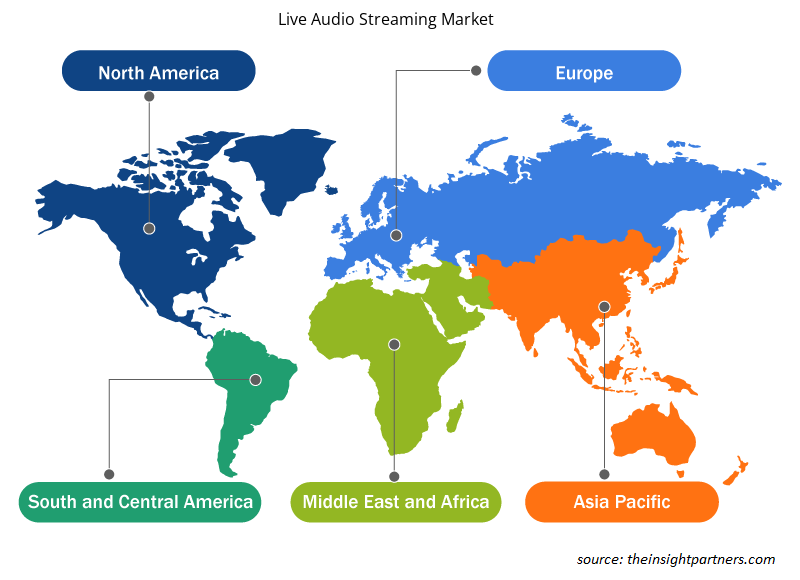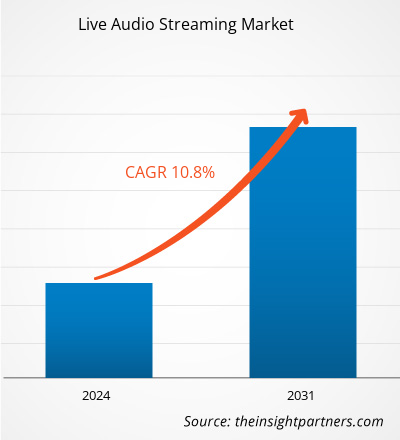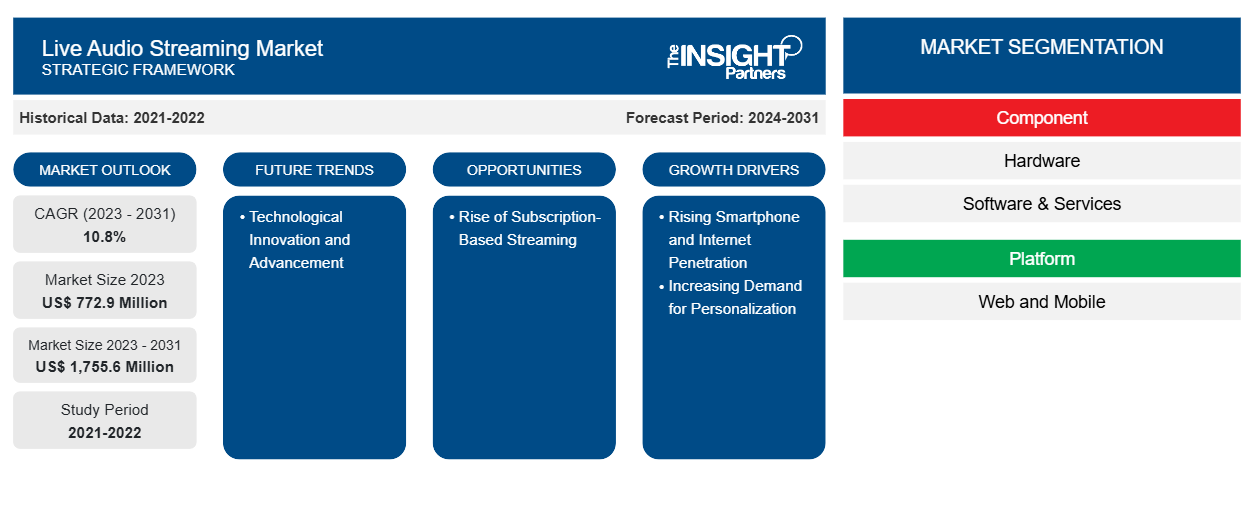Der Markt für Live-Audio-Streaming soll von 772,9 Millionen US-Dollar im Jahr 2023 auf 1.755,6 Millionen US-Dollar im Jahr 2031 anwachsen. Der Markt soll zwischen 2023 und 2031 eine durchschnittliche jährliche Wachstumsrate (CAGR) von 10,8 % verzeichnen. Die zunehmende Verbreitung von Smartphones und die zunehmende Internetdurchdringung werden voraussichtlich weiterhin die wichtigsten Trends im Markt für Live-Audio-Streaming bleiben.CAGR of 10.8% in 2023–2031. Rising smartphones and increasing internet penetration are likely to remain key live audio streaming market trends.
Marktanalyse für Live-Audio-Streaming
Streaming-Dienste nutzen ausgefeilte Algorithmen und KI, um die Vorlieben, Hörgewohnheiten und Situationsinformationen der Benutzer zu analysieren und ihnen personalisierte Musikempfehlungen zu liefern, die auf individuelle Vorlieben zugeschnitten sind. Maßgeschneiderte Musikvorschläge und handverlesene Wiedergabelisten sind entscheidend, um das Interesse und die Zufriedenheit der Benutzer zu wecken. Dieser maßgeschneiderte Ansatz verbessert das Benutzererlebnis und hält sie an der Plattform interessiert.
Marktübersicht für Live-Audio-Streaming
Live-Audio-Streaming ist die Echtzeitübertragung von Audioinhalten über eine Netzwerkverbindung, die dem Publikum eine sofortige Wiedergabe ermöglicht. Diese Technologie ermöglicht kontinuierliches Online-Streaming von Tonaufnahmen wie Vorträgen, Podcasts und Musik, ohne dass diese heruntergeladen werden müssen. Es liefert Audioinhalte über eine Internetverbindung und bietet direkten Zugriff auf gestreamte Inhalte sowie mehrere Optionen für den Zugriff auf Inhalte über verschiedene Geräte. Durch die Bereitstellung von Echtzeitverbindungen und -beteiligung hat Live-Streaming die Art und Weise verändert, wie globale Ereignisse erlebt werden, und damit unsere Sicht auf die Welt verändert. Darüber hinaus bieten Audio-Streaming-Plattformen Möglichkeiten, durch verschiedene Monetarisierungsmodelle Gewinne zu erzielen, was sie zu einer attraktiven Option für Unternehmen macht.
Passen Sie diesen Bericht Ihren Anforderungen an
Sie erhalten kostenlose Anpassungen an jedem Bericht, einschließlich Teilen dieses Berichts oder einer Analyse auf Länderebene, eines Excel-Datenpakets sowie tolle Angebote und Rabatte für Start-ups und Universitäten.
-
Holen Sie sich die wichtigsten Markttrends aus diesem Bericht.Dieses KOSTENLOSE Beispiel umfasst eine Datenanalyse von Markttrends bis hin zu Schätzungen und Prognosen.
Treiber und Chancen auf dem Markt für Live-Audio-Streaming
Steigende Smartphone- und Internetdurchdringung begünstigt den Markt
Die Nutzung von Smartphones und sozialen Medien ist in den meisten Schwellenländern weit verbreitet, was auf einen globalen Trend hin zur Smartphone-Nutzung und zum Internetzugang hindeutet. Die weit verbreitete Verfügbarkeit moderner Smartphones und Internetverbindungen hat dazu geführt, dass immer mehr Benutzer Online-Streaming-Dienste wählen. Im Januar 2024 hat die Zahl der einzelnen Mobilnutzer 5,61 Milliarden erreicht, wobei Smartphones etwa 85 Prozent der weltweit genutzten Mobiltelefone ausmachen. Ein wachsender Anteil der Nicht-Breitbandnutzer führt ihre Entscheidung, auf ein Highspeed-Internet-Abonnement zu Hause zu verzichten, darauf zurück, dass sie bei verschiedenen Online-Aktivitäten auf Smartphones angewiesen sind. Der mobile Datenverkehr ist kontinuierlich gestiegen, wobei der durchschnittliche monatliche Datenverkehr eines typischen Smartphone-Benutzers weltweit ein deutliches Wachstum aufweist. Der mobile Internetverkehr macht fast 60 Prozent des gesamten Webverkehrs aus, was den erheblichen Einfluss mobiler Geräte auf die Internetnutzung verdeutlicht.
Aufstieg des abonnementbasierten Streamings
Der Trend, dass Verbraucher kostenpflichtige Abonnements für werbefreies Musikstreaming, Offline-Hören, höhere Audioqualität und exklusive Inhalte wählen, nimmt zu. Dieser Trend wird durch die On-Demand-Wirtschaft beeinflusst, in der vernetzte Verbraucher bereit sind, für Komfort und sofortigen Zugriff auf Produkte und Dienste zu zahlen. Die Einfachheit, Erschwinglichkeit und das Wertversprechen von Abonnementmodellen sind die Haupttreiber dieses Trends. Abonnementmodelle bieten Verbrauchern Komfort und Flexibilität, während Unternehmen von einem kontinuierlichen Einnahmestrom und der Möglichkeit profitieren, Daten über das Nutzungsverhalten der Kunden zu sammeln. Diese Daten können genutzt werden, um das Produkt oder den Dienst zu verbessern und den steigenden Kundenerwartungen in Bezug auf On-Demand-Zugriff und Lieferung am selben Tag gerecht zu werden. All diese Faktoren werden voraussichtlich das Wachstum des Marktes für Live-Audiostreaming ankurbeln.
Segmentierungsanalyse des Live-Audio-Streaming-Marktberichts
Wichtige Segmente, die zur Ableitung der Marktanalyse für Live-Audio-Streaming beigetragen haben, sind Komponente, Plattform und Anwendung.
- Basierend auf den Komponenten ist der Markt in Hardware und Software & Services unterteilt. Das Segment Software & Services hatte im Jahr 2023 einen bedeutenden Marktanteil.
- Nach Plattform ist der Markt in Web und Mobile segmentiert. Das Mobile-Segment hielt im Jahr 2023 einen erheblichen Marktanteil.
- In Bezug auf die Anwendung ist der Markt in Unternehmen, Radio, Musikkonzerte und -veranstaltungen, Privat und Sonstiges unterteilt. Das Radiosegment hielt im Jahr 2023 einen erheblichen Marktanteil.
Marktanteilsanalyse für Live-Audio-Streaming nach geografischer Lage
Der geografische Umfang des Marktberichts zum Live-Audio-Streaming ist hauptsächlich in fünf Regionen unterteilt: Nordamerika, Asien-Pazifik, Europa, Naher Osten und Afrika sowie Südamerika/Süd- und Mittelamerika.
Der Markt für Live-Audio-Streaming in Nordamerika verzeichnet ein beträchtliches Wachstum und wird in den kommenden Jahren voraussichtlich weiter wachsen. Der Live-Streaming-Markt in Nordamerika wird voraussichtlich einen bedeutenden Anteil halten, gekennzeichnet durch die Präsenz großer Technologieunternehmen, eine fortschrittliche Internetinfrastruktur und eine große Verbraucherbasis mit hoher digitaler Konnektivität. Die weit verbreitete Verfügbarkeit von Internetverbindungen und die zunehmende Abhängigkeit von Webbrowsern für verschiedene Aktivitäten, einschließlich browserbasiertem Musik- Streaming, tragen zum Marktwachstum in der Region bei.
Regionale Einblicke in den Markt für Live-Audio-Streaming
Die regionalen Trends und Faktoren, die den Live-Audio-Streaming-Markt während des Prognosezeitraums beeinflussen, wurden von den Analysten von Insight Partners ausführlich erläutert. In diesem Abschnitt werden auch die Marktsegmente und die Geografie des Live-Audio-Streaming-Marktes in Nordamerika, Europa, im asiatisch-pazifischen Raum, im Nahen Osten und Afrika sowie in Süd- und Mittelamerika erörtert.

- Holen Sie sich regionale Daten zum Live-Audio-Streaming-Markt
Umfang des Marktberichts zum Live-Audio-Streaming
| Berichtsattribut | Details |
|---|---|
| Marktgröße im Jahr 2023 | 772,9 Millionen US-Dollar |
| Marktgröße bis 2031 | 1.755,6 Millionen US-Dollar |
| Globale CAGR (2023 - 2031) | 10,8 % |
| Historische Daten | 2021-2022 |
| Prognosezeitraum | 2024–2031 |
| Abgedeckte Segmente |
Nach Komponente
|
| Abgedeckte Regionen und Länder |
Nordamerika
|
| Marktführer und wichtige Unternehmensprofile |
|
Marktteilnehmerdichte: Der Einfluss auf die Geschäftsdynamik
Der Markt für Live-Audio-Streaming wächst rasant, angetrieben durch die steigende Nachfrage der Endnutzer aufgrund von Faktoren wie sich entwickelnden Verbraucherpräferenzen, technologischen Fortschritten und einem größeren Bewusstsein für die Vorteile des Produkts. Mit steigender Nachfrage erweitern Unternehmen ihr Angebot, entwickeln Innovationen, um die Bedürfnisse der Verbraucher zu erfüllen, und nutzen neue Trends, was das Marktwachstum weiter ankurbelt.
Die Marktteilnehmerdichte bezieht sich auf die Verteilung der Firmen oder Unternehmen, die in einem bestimmten Markt oder einer bestimmten Branche tätig sind. Sie gibt an, wie viele Wettbewerber (Marktteilnehmer) in einem bestimmten Marktraum im Verhältnis zu seiner Größe oder seinem gesamten Marktwert präsent sind.
Die wichtigsten Unternehmen auf dem Markt für Live-Audio-Streaming sind:
- Adobe Inc.
- Bloomberg LP
- DACAST
- Lime Broadcast Gruppe
- LINEAPP GmbH
- Live365
Haftungsausschluss : Die oben aufgeführten Unternehmen sind nicht in einer bestimmten Reihenfolge aufgeführt.

- Überblick über die wichtigsten Akteure auf dem Markt für Live-Audio-Streaming
Neuigkeiten und aktuelle Entwicklungen zum Markt für Live-Audio-Streaming
Der Markt für Live-Audio-Streaming wird durch die Erhebung qualitativer und quantitativer Daten nach Primär- und Sekundärforschung bewertet, die wichtige Unternehmensveröffentlichungen, Verbandsdaten und Datenbanken umfasst. Im Folgenden finden Sie eine Liste der Entwicklungen auf dem Markt:
- FOX News Audio hat seine Partnerschaft mit Audacy um FOX Weather erweitert, den kostenlosen, werbefinanzierten Streaming-TV-Wetterdienst („FAST“) von FOX News Media. Mit Wirkung zum 1. November erweitert der Vertrag die bestehende Beziehung von FOX News Audio mit Audacy, das auch FOX News Podcasts und die FOX News Talk-Audiostreams vertreibt.
(Quelle: FOX News Audio, Unternehmenswebsite, 2024)
Marktbericht zum Live-Audio-Streaming – Abdeckung und Ergebnisse
Der Bericht „Marktgröße und Prognose für Live-Audio-Streaming (2023–2031)“ bietet eine detaillierte Analyse des Marktes, die die folgenden Bereiche abdeckt:
- Marktgröße und Prognose auf globaler, regionaler und Länderebene für alle wichtigen Marktsegmente, die im Rahmen des Projekts abgedeckt sind
- Marktdynamik wie Treiber, Beschränkungen und wichtige Chancen
- Wichtige Zukunftstrends
- Detaillierte PEST/Porters Five Forces- und SWOT-Analyse
- Globale und regionale Marktanalyse mit wichtigen Markttrends, wichtigen Akteuren, Vorschriften und aktuellen Marktentwicklungen
- Branchenlandschaft und Wettbewerbsanalyse, einschließlich Marktkonzentration, Heatmap-Analyse, prominenten Akteuren und aktuellen Entwicklungen
- Detaillierte Firmenprofile
- Historische Analyse (2 Jahre), Basisjahr, Prognose (7 Jahre) mit CAGR
- PEST- und SWOT-Analyse
- Marktgröße Wert/Volumen – Global, Regional, Land
- Branchen- und Wettbewerbslandschaft
- Excel-Datensatz
Aktuelle Berichte
Verwandte Berichte
Erfahrungsberichte
Grund zum Kauf
- Fundierte Entscheidungsfindung
- Marktdynamik verstehen
- Wettbewerbsanalyse
- Kundeneinblicke
- Marktprognosen
- Risikominimierung
- Strategische Planung
- Investitionsbegründung
- Identifizierung neuer Märkte
- Verbesserung von Marketingstrategien
- Steigerung der Betriebseffizienz
- Anpassung an regulatorische Trends























 Kostenlose Probe anfordern für - Markt für Live-Audio-Streaming
Kostenlose Probe anfordern für - Markt für Live-Audio-Streaming